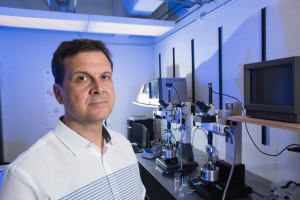A new paper from the Vekilov Research Group at the University of Houston’s Cullen College of Engineering is shedding light on how crystals form, and in the process, overturning a belief held for more than a century.
Dr. Peter G. Vekilov, the John and Rebecca Moores Professor in the Department of Chemical and Biomolecular Engineering, is lead author for “Olanzapine crystal symmetry originates in preformed centrosymmetric solute dimers,” which was published in late September by Nature Chemistry. It was also featured on Nature Chemistry’s social media account in October.
Additional authors include UH doctoral student Lakshmanji Verma and Dr. Jeremy C. Palmer of the Department of Chemical and Biomolecular Engineering; and Monika Warzecha, Blair F. Johnston and Alastair J. Florence of EPSRC CMAC Future Manufacturing Research Hub at the Strathclyde Institute of Pharmacy and Biomedical Sciences Technology and Innovation Centre in Glasgow, United Kingdom. Johnston is also with the National Physical Laboratory in Teddington in the United Kingdom.
Vekilov described his work as delving into the very nature and formation of some of the world’s most well-known structures.
“We are all fascinated by the glitz of diamonds, the etherealness of snowflakes and the power of silicon to run our communications, creativity and entertainment,” he said. “These materials are, obviously, as diverse as that can be, but they have one common property that defines their beauty and utility – their crystal symmetry. In a crystal, atoms and molecules arrange in a repeated pattern in which the location of any element is strictly related to the locations of the others. The rules that govern these spatial relationships are called symmetry.”
Vekilov noted that for almost a century, there was a belief when it came to crystals.
“In the 1920s, it was established that the symmetry of molecules does not in any way correlate with the symmetry of the crystal in which it enlists,” he said. “The same carbon atoms can arrange in both hexagonal and cubic patterns. The former is humble graphite and the latter, shiny diamond. Two straightforward conclusions from here are that crystal symmetry arises when the crystal forms by the assembly of molecules and that we cannot control it.”
However, the recent work by his group suggests that crystal symmetry does not arise exclusively during crystallization, disproving this century-old postulate.
“Working with the groups of professors Alastair Florence and Jeremy Palmer, we demonstrated that one of the symmetry elements of olanzapine crystals, an inversion center, arises in the solution prior to crystallization in the form of centrosymmetric dimers,” he said. “Olanzapine is an antipsychotic drug used to treat schizophrenia and bipolar disorder. The insights that dimers that carry an element of crystal symmetry exist in the solution has tremendous practical consequences. It provides the first tool to control crystal symmetry, for instance, by additives that promote or suppress the formation of symmetric crystallization precursors.”
Being able to rationally control crystal symmetry would have profound implications for the pharmaceutical industry.
“The Vekilov group now focuses on adjacent open questions of crystal growth theory and practice,” he said. “A fundamental question valid for solutions in which monomers and dimers coexist with a continuum of solute species is how these species transform into the unique configuration acceptable to the crystal? Other questions touch on crystallization control employing modifiers that interact with the crystal surfaces. Beyond the realms of crystallization, we’re also exploring the molecular mechanisms of aggregation of the Amyloid beta peptide that causes Alzheimer’s disease. Another area of concentration is the condensates formed by the protein p53, implicated in the majority of human cancers.”
